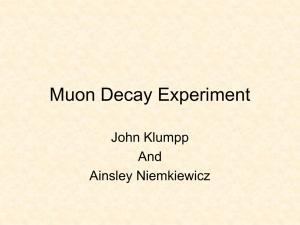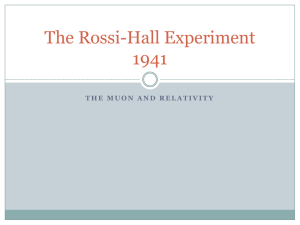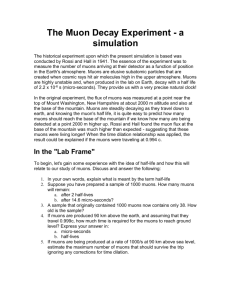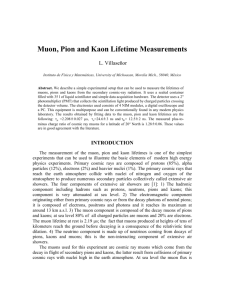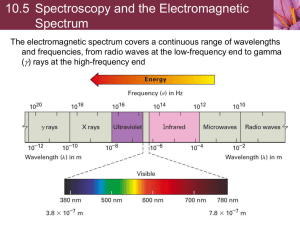stopped cosmic-ray muons in ground based and shallow
advertisement
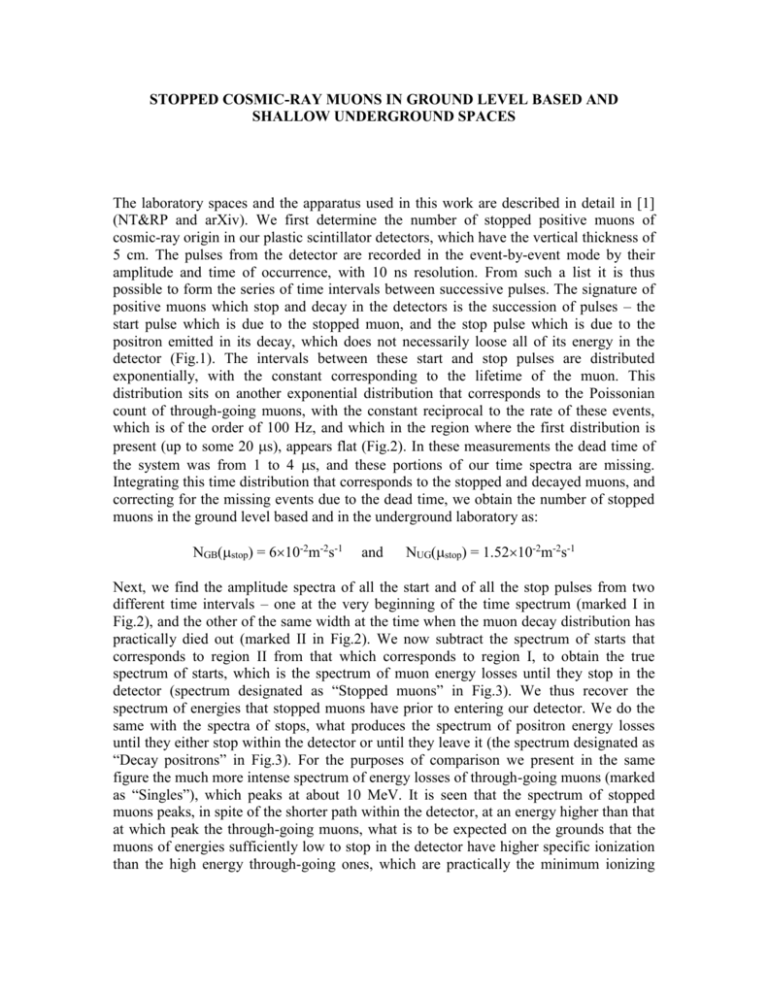
STOPPED COSMIC-RAY MUONS IN GROUND LEVEL BASED AND SHALLOW UNDERGROUND SPACES The laboratory spaces and the apparatus used in this work are described in detail in [1] (NT&RP and arXiv). We first determine the number of stopped positive muons of cosmic-ray origin in our plastic scintillator detectors, which have the vertical thickness of 5 cm. The pulses from the detector are recorded in the event-by-event mode by their amplitude and time of occurrence, with 10 ns resolution. From such a list it is thus possible to form the series of time intervals between successive pulses. The signature of positive muons which stop and decay in the detectors is the succession of pulses – the start pulse which is due to the stopped muon, and the stop pulse which is due to the positron emitted in its decay, which does not necessarily loose all of its energy in the detector (Fig.1). The intervals between these start and stop pulses are distributed exponentially, with the constant corresponding to the lifetime of the muon. This distribution sits on another exponential distribution that corresponds to the Poissonian count of through-going muons, with the constant reciprocal to the rate of these events, which is of the order of 100 Hz, and which in the region where the first distribution is present (up to some 20 s), appears flat (Fig.2). In these measurements the dead time of the system was from 1 to 4 s, and these portions of our time spectra are missing. Integrating this time distribution that corresponds to the stopped and decayed muons, and correcting for the missing events due to the dead time, we obtain the number of stopped muons in the ground level based and in the underground laboratory as: NGB(stop) = 610-2m-2s-1 and NUG(stop) = 1.5210-2m-2s-1 Next, we find the amplitude spectra of all the start and of all the stop pulses from two different time intervals – one at the very beginning of the time spectrum (marked I in Fig.2), and the other of the same width at the time when the muon decay distribution has practically died out (marked II in Fig.2). We now subtract the spectrum of starts that corresponds to region II from that which corresponds to region I, to obtain the true spectrum of starts, which is the spectrum of muon energy losses until they stop in the detector (spectrum designated as “Stopped muons” in Fig.3). We thus recover the spectrum of energies that stopped muons have prior to entering our detector. We do the same with the spectra of stops, what produces the spectrum of positron energy losses until they either stop within the detector or until they leave it (the spectrum designated as “Decay positrons” in Fig.3). For the purposes of comparison we present in the same figure the much more intense spectrum of energy losses of through-going muons (marked as “Singles”), which peaks at about 10 MeV. It is seen that the spectrum of stopped muons peaks, in spite of the shorter path within the detector, at an energy higher than that at which peak the through-going muons, what is to be expected on the grounds that the muons of energies sufficiently low to stop in the detector have higher specific ionization than the high energy through-going ones, which are practically the minimum ionizing particles. Fig. 3b presents the same results for the identical detector situated in the underground laboratory. Comparison between Fig. 3a and 3b shows that the muons which Fig.1. Definitions of the quantities involved in the study of CR muons which stop and decay in plastic scintillator detectors 5 cm thick Fig.2. Distribution of time intervals between successive pulses from the 1m2 plastic scintillator detector. Region I contains majority of the stopped muon decays, while region II contains only the “background” composed only of time intervals between the throughgoing high-energy muons Fig.3 a. The spectra of through-going muons (Singles), of stopped muons (Starts, or Stopped muons) and of decay positrons (Stops, or Decay positrons, all in the ground level based laboratory (Surface), b. Same, in the underground laboratory (Cavern). Negative counts are due to channel-by-channel subtraction of the spectra stop underground peak at an energy slightly over 20 MeV, while those which stop at the surface peak at somewhat lower energy. The difference between the spectra of decay positrons is even more pronounced. Spectrum of energy losses of decay positrons on the surface exhibit a complex structure; the low energy portion of the spectrum ceases at about 4 MeV; the higher energy portion peaks at about 7 MeV, and the still higher energy losses with decreasing intensity stretch up to about 50 MeV. The corresponding spectrum in the underground does not exhibit this threefold structure, at lower energies the single structure peaks at about 6 MeV, and the low intensity higher energy portion stretches again up to about 50 MeV. The difference between the low-energy parts of the two spectra possibly arises from different degree of polarization of the stopped muons, those in the underground being perhaps practically depolarized, and those on the surface retaining still a significant degree of polarization (?!?). This would, by virtue of parity non-conservation in the weak interactions involved, lead to different angular distributions of decay positrons, what would in turn result in the observed differences in their corresponding energy-loss spectra. To check the above assumption we arranged the triple sandwich arrangement of plastic scintillator detectors, the big plastic detector (1 m2) sandwiched between the two small ones (0.125 m2), the pulses from each detector being recorded by their amplitudes and time of occurrence, with 10 ns resolution. All relevant combinations of off-line coinciding and anti-coinciding between the detectors yielded the information that we discuss in what follows. We first comment on the results of these measurements performed in the ground based laboratory (Dime). Fig. 4 shows the disposition of the detectors and all possible events, out of which we look only for the spectra of those which satisfy the condition that they trigger only the upper and central detector and which have as a successive event, within couple of lifetimes of the muon, the coincidence of the central detector either with the upper or the lower detector. The background, which is subtracted from these spectra, satisfies the same conditions, except that the successive events that follow the decay of the stopped muon are delayed for more than about ten lifetimes of the muon. All other uninteresting events that do not satisfy this complex condition are rejected. Fig. 4. The disposition of the detectors in the experiment which is set to measure the polarization of CR muons, by looking for the asymmetry between the events marked as A and B After bringing all the spectra to the same energy scale, the off-line analysis as described above yields the spectra presented in Fig .5. Fig. 5. The spectra of total energy that decay positrons deposit in the central detector, in which they stop, and either in the upper detector (A), or in the lower detector (B) Since the angular distribution of the incoming muons is wide, and the overall geometry of the events included into these spectra is complex, it is not possible to interpret and draw meaningful quantitative conclusions from the significant differences that exist between the two spectra. It is, however, evident that the number of positrons that are emitted into the upper hemisphere is significantly bigger than the number of those emitted into the lower hemisphere. This alone already witnesses that muons arrive at the surface of the Earth with significant polarization, retained from the act of their creation in the decay of correspondingly polarized pions. Now, we HAVE TO demonstrate that in the underground the degree of polarization of stopped muons is indeed much smaller than on the surface !!!???!!! …………….
